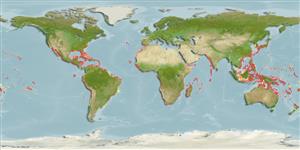Classification / Names
Common names from other countries
Main reference
Size / Weight / Age
Max length : 328 cm WD male/unsexed; (Ref. 58048); 305.2 cm WD (female); common length : 250 cm WD male/unsexed; (Ref. 9256); max. published weight: 350.0 kg (Ref. 50641)
Environment
Marine; reef-associated; oceanodromous (Ref. 51243); depth range 0 - 30 m (Ref. 58047), usually 0 - 20 m (Ref. 89972)
Climate / Range
Tropical, preferred ?
Distribution
Circumtropical, recorded from scattered localities. Western Atlantic: off Venezuela. Eastern Atlantic: Côte d'Ivoire and South Africa. Reported from Cape Verde (Ref. 34514). Western Indian Ocean: northwestern Red Sea. Western Pacific: Japan, Taiwan, and probably tropical Australia. Eastern Pacific: Gulf of California and Chile.
Countries | FAO areas | Ecosystems | Occurrences | Introductions
Short description
A large devil ray with a long head bearing short head fins; dorsal fin plain, and pectoral fins with strongly curved, swept-back tips; upper disc densely covered with small, pointed denticles and tail shorter than disc with no spine (Ref. 5578). Dark blue (Ref. 5578), olive-green to brownish above; ventral side white anteriorly, grey posteriorly, with an irregular but distinct line of demarcation (Ref. 11228). No caudal fin (Ref. 5578).
IUCN Red List Status (Ref. 115185)
Threat to humans
Harmless
Human uses
Fisheries: subsistence fisheries
More information
ReferencesAquacultureAquaculture profileStrainsGeneticsAllele frequenciesHeritabilityDiseasesProcessingMass conversion
Tools
Special reports
Download XML
Internet sources
Estimates of some properties based on models
Phylogenetic diversity index
PD50 = 0.5020 many relatives (e.g. carps) 0.5 - 2.0 few relatives (e.g. lungfishes)
Trophic Level
3.8 ±0.59 se; Based on food items.
Resilience
Very Low, minimum population doubling time more than 14 years (Fec=1)
Vulnerability
High vulnerability (55 of 100)
Price category
